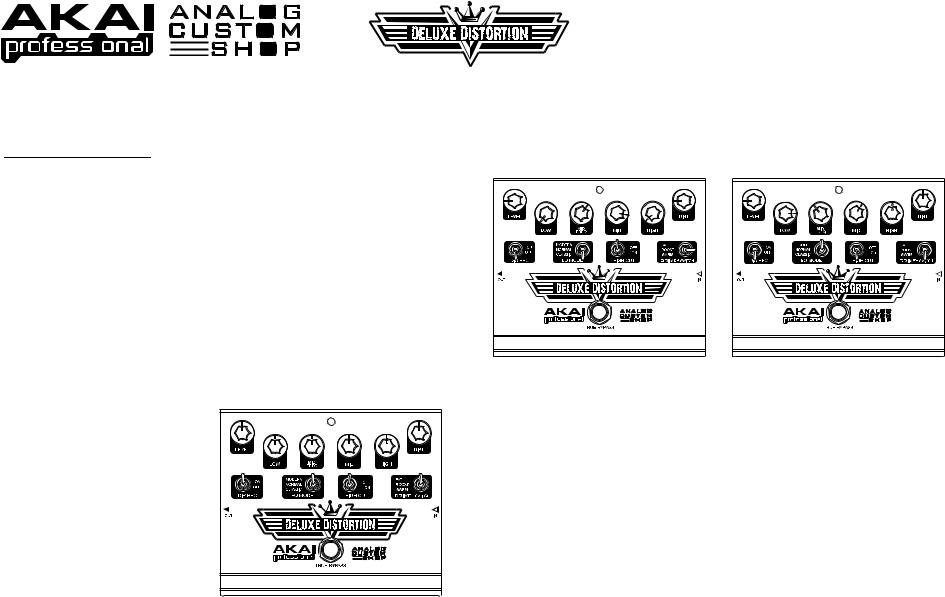Akai Deluxe Distortion Quick Start Guide [en, es]

Thank you for purchasing the Analog Custom Shop Deluxe Distortion!
Please read the important notes in this Quickstart Guide to ensure the best possible experience with your new pedal.
A few notes about power:
Battery:
•To install the included 9V battery, remove the battery cover on the bottom panel of the pedal. Snap the terminal connector's onto the battery's terminals. Replace the cover, and you're ready to play!
•When using battery power, disconnect your cable from the pedal's input jack when you are not playing. (The input jack works like an on/off switch for battery power.)
•If you are not going to use your pedal for an extended period, disconnect and remove the battery. Over long periods of time, batteries can sometimes leak, and their acid or other residue can damage the pedal. Damage caused by battery leakage is not covered under warranty.
Power adapter (optional):
•To power the pedal with a power adapter, we recommend purchasing the Akai MP9-P6 (9V DC, 300 mA [200 mA minimum], center-negative).
Description: The Deluxe Distortion is one of the most versatile distortion pedals out there. It has builtin equalization controls – low, high, and mid with adjustable frequency. A subtle EQ change can make a big difference in your tone. This pedal also has two distinct circuits – an LED distortion and a diode distortion – allowing you to get many of the classic sounds of other pedals on the market. We've also added a third mode, which is a combination of both circuits, allowing for a new type of sound, combining it with the more traditional distortion. Whether you're playing blistering leads or thick chords, this pedal boasts superior tone and clarity. We're sure you'll find your sound with the Deluxe Distortion!
The controls:
LEVEL: Turn this knob to adjust the pedal's output volume.
LOW: Turn this knob to adjust the amount of "boost" or "cut" to the low frequencies of your sound.
MID FREQ: Turn this knob to set the mid frequency band that will be "boosted" or "cut" by the MID knob.
MID: Turn this knob to adjust the amount of "boost" or "cut" to the mid frequency of your sound. The frequency band can be set by the MID FREQ knob.
HIGH: Turn this knob to adjust the amount of "boost" or "cut" to the high frequencies of your sound.
DISTORTION: Turn this knob to adjust the amount of distortion in your sound.
DIR REC: Setting this switch to "on" will enhance the signal with an amp simulator, creating a sound you might get from an amp, which is useful if you are recording direct – or simply as another tone control.
EQ MODE: Use this switch to select one of three different peak curves for the MID FREQ knob. Try boosting the mids and sweeping the MID FREQ knob to hear the effect.
HIGH CUT: Setting this switch to "on" will cut the high frequency of your sound (~3 kHz) by 15 dB.
DRIVE3 SWITCH: Use this switch to select the type of drive circuit. The three settings vary a bit in gain structure and tone, which you'll notice most in the "attack" of your sound.
BYPASS SWITCH: Step on this switch to turn the effect on or off. This pedal features a true bypass switch, meaning your signal won't be colored by the pedal's circuitry when the effect is off.
QUICKSTART GUIDE (ENGLISH)
7-51-0345-A
Suggested settings:
The Deluxe Distortion can give you a wide spectrum of distorted sounds – from a light distortion to full-on fuzz. Adjust the equalization controls to try out the amount of "cut" or "boost" that's ideal for your sound. Also experiment with the different settings of the DRIVE3 SWITCH.
Here are a few suggested settings to get you started:
AM radio / 6" practice amp |
Big and phat |
Notes about signal flow:
Where you place the Deluxe Distortion in your effects chain will change how it works and influences the sound of your other effects.
•Placing it after a compressor can make for a great sustainer. The increased sustain of both pedals can create some smooth tones that are ideal for solos.
•Placing it after an overdrive pedal helps drive its distortion even harder while also boosting the low end, giving the sound more depth.
•Most of the time, it's recommended that the Deluxe Distortion be placed before modulation effects (flanger or chorus) or delay effects, but don't let that stop you from trying the overdrive at the end of your effects chain.
•Experiment with the Deluxe Distortion's placement in your effects chain. Play around with some new and interesting tones – and find your sound in the process!
www.akaipro.com
